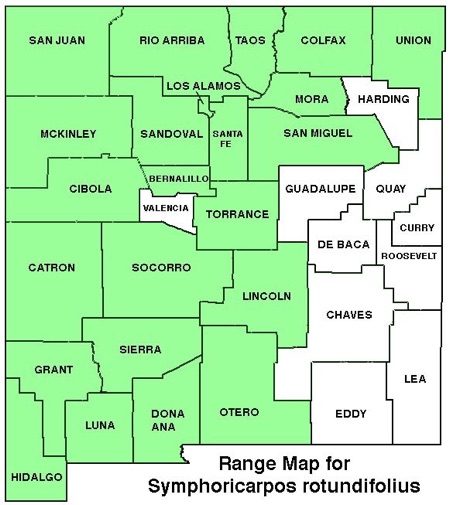WILDFLOWERS OF NEW MEXICO

Erect to spreading, arching shrubs 3–6 feet tall have shredding bark and rounded, opposite leaves. Note the pink to white, trumpet-shaped flowers, and snow-white berries.
FLOWERS: May–July. Clusters on branch tips and in leaf axils have 2 or more trumpet-shaped flowers; floral tube 5/16–3/8 inch long (8–10 mm), with 5 erect to spreading, round-tipped petal-lobes much shorter than the floral tube; stamens held within floral tube and lobes. Fruit is a white, round drupe 3/16–9/16 inch diameter (5–15 mm); toxic to animals so often on plant throughout winter.
LEAVES: Opposite, short stalked. Blades rounded to oval, 3/8–1 1/4 inches long (1–3 cm); edges entire to slightly toothed, often on same plant; surfaces smooth (S. rotundifolius) to minutely soft hairy (S. oreophilus).
HABITAT: Moist to dry open woodlands, slopes; Gamble oak foothills, ponderosa-Douglas fir, spruce-fir, aspen forests.
ELEVATION: 5,800–10,200 feet (1786–3109 m).
RANGE: Rocky Mts. and all states westward; Canada.
SIMILAR SPECIES: Various floras describe these as two separate species distinguished by twig and foliage hair characteristics. Others lump them as one species using either name. Flora Neomexicana III (Allred, 2020) combines the species as S. rotundifolius, while Flora of the Four Corners Region (Heil, 2013) lumps both species as S. oreophilus. White Snowberry, S. albus, has bell-shaped flowers with the petal lobes as long as the floral tube.
NM COUNTIES: Nearly statewide, except eastern plains counties, in mid- to high-elevation habitats: Bernalillo, Catron, Cibola, Colfax, Dona Ana, Grant, Hidalgo, Lincoln, Los Alamos, Luna, McKinley, Mora, Otero, Rio Arriba, San Juan, San Miguel, Sandoval, Santa Fe, Sierra, Socorro, Taos, Torrance, Union.









ROUNDLEAF SNOWBERRY
SYMPHORICARPOS ROTUNDIFOLIUS (incl. S. oreophilus)
Honeysuckle Family, Caprifoliaceae
Deciduous shrub


















THE CONTENTS OF THIS WEBSITE ARE COPYRIGHTED AND CANNOT BE USED
WITHOUT PERMISSION OF GEORGE OXFORD MILLER
















EMAIL ME


















The nectar-rich flowers attract butterflies and other pollinators, but the white fruit are poisonous to birds and other animals.










The floral tube is much longer than the petal-like lobes.







